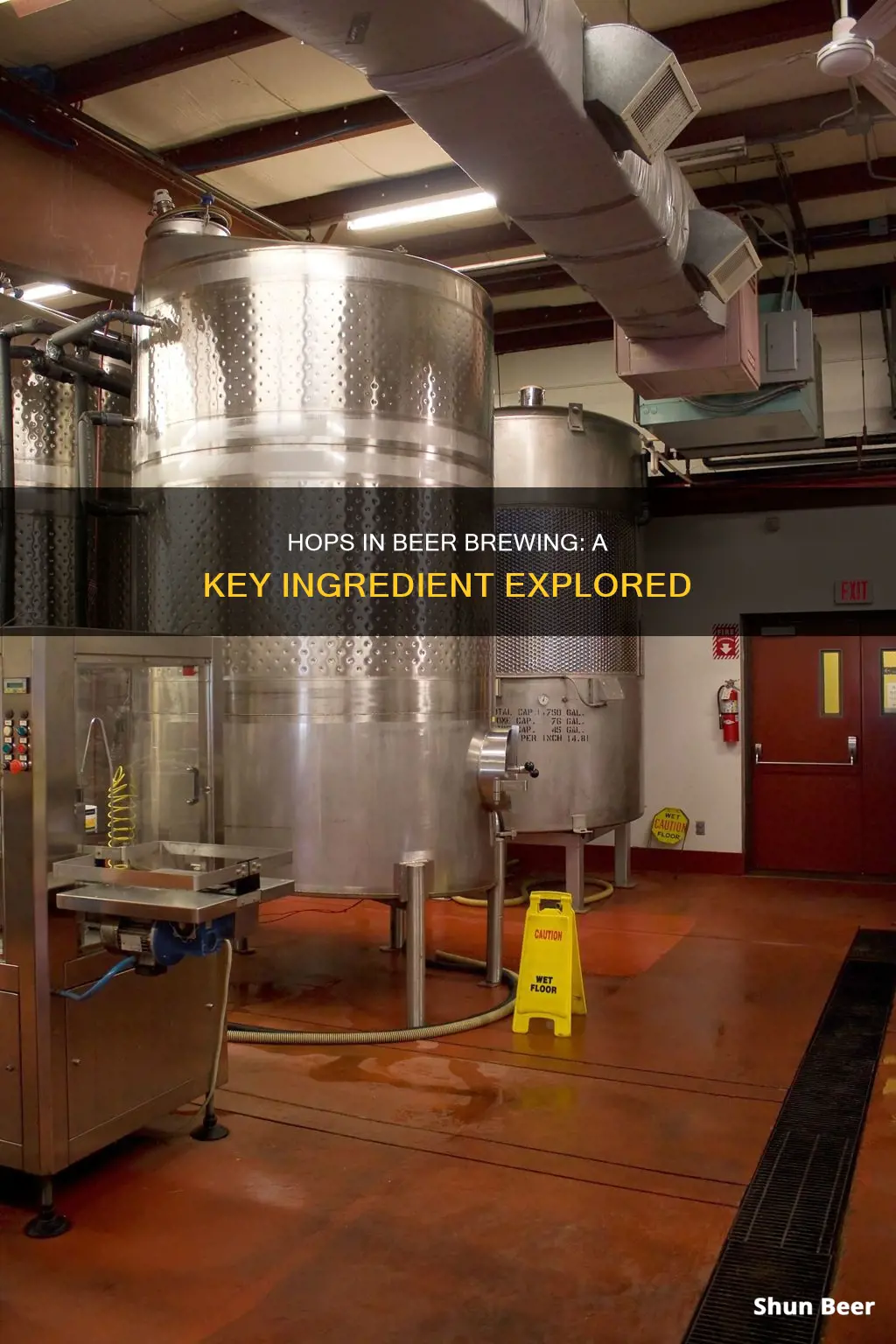
Hops are a key component in the beer-making process. They are the flowers, or cones, of a plant called Humulus lupulus and are used primarily as a bittering, flavouring, and stabilising agent in beer. They add bitterness and other flavours and act as a natural preservative. They are one of four essential ingredients in beer, alongside barley, yeast, and water.
What You'll Learn

Hops are the flowers of the hop plant Humulus lupulus
Hops are the flowers of the hop plant, Humulus lupulus. They are one of the four essential ingredients in beer, alongside barley, yeast, and water. Hops add bitterness, flavour, and stability to the finished beer. They are cone-shaped flowers from the female hops plant and contain acids and oils that give the beer its distinctive characteristics.
Humulus lupulus is a member of the Cannabinaceae family, which also includes Cannabis (hemp and marijuana). The hop plant is a vigorous, climbing, herbaceous perennial that is usually trained to grow up strings in a field called a hopfield or hop yard. The first documented use of hops in beer dates back to the 9th century, but they didn't become widespread until the 13th century when they started to replace gruit, a mixture of bitter herbs and flowers, as the primary flavouring agent.
Hops have two main varieties: bittering and aroma. Bittering hops have higher concentrations of alpha acids, which contribute to the bitter flavour of beer. Aroma hops, on the other hand, tend to have more essential oils that give off the "hoppy" aroma and flavour. The choice and timing of adding hops during the brewing process will vary depending on the desired style and flavour profile of the beer.
Hops are typically added during the boil stage of brewing, as it takes around an hour to extract the "alpha" acids that provide bitterness and balance the sweetness of the malt. However, hops can also be added later in the boil to preserve aromatic oils or even added directly to the fermenter in a technique known as "dry hopping".
In addition to their flavour and aroma contributions, hops also have antibacterial properties that help prevent spoilage and extend the shelf life of beer. They aid in head retention, helping the beer retain its head of foam, which is crucial to the beer's aroma and flavour.
Hops: Brewing Demand and Future Growth
You may want to see also

Hops add bitterness, flavour, and stability to beer
Hops are the flowers, or cones, of the plant Humulus lupulus, a member of the Cannabinaceae family, which also includes cannabis. They are one of the four essential ingredients in beer, alongside barley, yeast, and water. Hops add bitterness, flavour, and stability to the finished beer.
The first documented use of hops in beer was in the 9th century, although hops were not widely cultivated for use in beer until the 13th century. Hops contain alpha acids or humulones, which are responsible for the bitter taste of beer. During the wort boiling process, humulones are thermally isomerized into iso-alpha acids or isohumulones. The degree of bitterness imparted by hops depends on the degree to which alpha acids are isomerized during the boil.
Hops also contain beta acids or lupulones, which contribute desirable aromas to beer. The main components of hops essential oils are terpene hydrocarbons, including myrcene, humulene, and caryophyllene. Together, these three compounds represent 80 to 90% of the total hops essential oil. Hops have an antibacterial effect, suppressing the growth of undesirable microorganisms and aiding in "head retention", or the length of time that a foamy head created by carbonation will last.
The choice and timing of hops addition during the brewing process will vary depending on the style of beer being brewed and the desired flavour profile. Hops can be added early in the brewing process, which allows the essential oils to volatilize, either during the boil or during fermentation. Adding hops later in the boil helps preserve aromatic oils, as they are destroyed during a long boiling process. Hops can also be added during fermentation, a technique known as "dry hopping", which contributes to the hop aroma.
Hops are typically boiled for 60-90 minutes, and the longer they are boiled, the more bitterness they contribute to the beer. However, boiling for a longer period also results in inferior aromatic properties, as the aromatic compounds evaporate.
The Evolution of Tropical Hops in Beer
You may want to see also

Hoppy beers are a recent trend
Hops are the cone-shaped flowers of the female hops plant, aka Humulus lupulus. They contain acids and oils that impart bitterness, flavour, and stability to the finished beer. Hops are typically added to the boil stage of brewing, as it takes a long time (around an hour) to unleash the "alpha" acids that bitter and balance the sweetness of the malt.
The phrase "hoppy beer" can refer to a beer's smell, its flavour profile, or the literal volume of hops in its recipe. When we talk about hoppiness, it's a mistake to think only of bitterness. A high IBU (International Bitterness Units) beer will certainly require a lot of hops, but bitterness only tells part of the "flavour story". A high IBU beer can also be balanced against a huge malt profile (like a stout or porter), which you would arguably not call a "hoppy beer".
"Hoppy" can mean "the opposite of malty", as well as "you taste lots of hops". This dichotomy of hops use is why hops are classified as "Bittering Hops", "Aroma Hops", and hops that can serve both functions – "Dual Use".
The length of time hops are boiled brings out different flavour characteristics. The longer hops are boiled, the more bitter the flavour. Many hop flavours can be completely eradicated with too long in high temperatures.
The amount of bitterness that hops lend to beer can be a bit of a challenge for those who aren't used to it. You could say it's an acquired taste, but some people may never really "acquire" it. However, that doesn't mean beer is completely off the table for those drinkers. There are plenty of beers that feature either a very low amount of hops or no hops at all. Many ancient styles of beer have been around even longer than hops.
Hops in Near Beer: What's the Deal?
You may want to see also

Hops are added to the boil stage of brewing
Hops are typically added in three stages during the boil: bittering, flavour, and aroma. The same hop variety can be used for all three stages. However, the timing of the addition will affect the flavour of the beer. For example, hops added at the start of the boil are primarily for bittering, while those added towards the end are for flavour and aroma.
The timing of hop additions depends on the desired flavour profile and style of the beer. For instance, a beer with a more prominent hops flavour might add hops post-boil, while a darker ale might use hops for structural support and to emphasise other flavours.
It's worth noting that the choice of hop variety and its point of origin can also impact the flavour of the beer. Different varieties will have varying concentrations of alpha acids, beta acids, and hops oils, all of which contribute to the unique characteristics of the final product.
Sedative Hops: Brewing Relaxing Beers With These Hops
You may want to see also

There are two main types of hops: bittering and aroma
Hops are one of the four essential ingredients in beer, alongside barley, yeast, and water. They are the cone-shaped flowers of the female hops plant, or Humulus lupulus. Hops contain acids and oils that impart bitterness, flavour, and stability to the finished beer.
There are two main types of hops used in quality beer brewing: aroma hops and bittering hops. They serve separate purposes.
Bittering Hops
Without bittering hops, beers would be overly sweet. The bitterness in hops comes from alpha acids present in hop flowers. The longer the hops are boiled, the more bitter the beer. Brewers use a scale called International Bitterness Units (IBU) to measure the active ingredient in alpha acids, isohumulone, in parts per million. Isohumulone is extracted during the boiling process. Bittering hops are added early in the boil.
Aroma Hops
Aroma hops are introduced to the brew at the end of the boiling process, or after the boil has completely subsided as the mixture ferments. This is because the volatile nature of the essential oils contained in hops causes them to evaporate very quickly. Aroma hops are used to provide the beer with a final layer of finish.
Dual-Purpose Hops
Some hops are used for both bittering and aroma and are referred to as dual-purpose hops. Hops such as Citra, El Dorado, Simcoe, and Cascade are used at all stages of the brewing process and are commonly used in Pale Ales and IPAs.
The Ultimate Guide to Choosing the Right Hops for Your Beer
You may want to see also
Frequently asked questions
Hops are the cone-shaped flowers of the female hops plant, Humulus lupulus.
Hops are one of four essential ingredients in beer. They add bitterness, flavour, and stability to the finished beer. Hops also balance the sweetness of the malt and have an antibacterial effect, preventing spoilage.
Hops are typically added during the boil stage of brewing to unleash their bitter "alpha" acids. They may be added at different times, depending on the desired flavour and aroma. Hops can also be dry-hopped or fresh-hopped.







